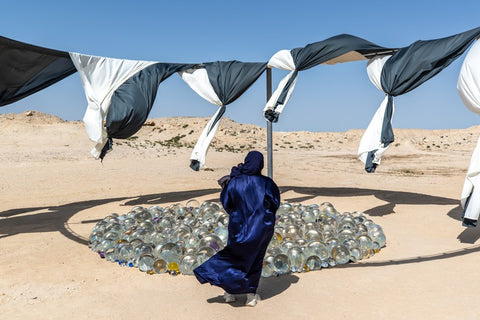The Curious Desert
Now that the reality of climate change and the growing impact it has on people’s daily lives is undeniable, artists are more than ever dedicated to using their creations to inspire the examination of humankind’s impact on the environment. Last week, a sprawling exhibition of Olafur Eliasson, who is consistently inspired by the relationship between people and nature, opened in Qatar. The curious desert (open until 15 August), Eliasson’s first solo exhibition in the Gulf region, is part of Qatar Creates cultural movement and takes place across both the Al Thakhira Mangrove Nature Preserve, a sabkha (coastal sandflat) habitat 64km northeast of the capital and the Jean Nouvel-designed National Museum of Qatar in Doha.

The Icelandic-Danish artist uses the outdoor space as an art laboratory. Installations across twelve pavilions experiment with light and colour, geometric studies, and ecological awareness. Each pavilion employs one of the natural forces to create a physical artwork (which is then displayed in the indoor part of the exhibition), a happening or an event. According to Eliasson: ‘the sun, the wind, the nearby lagoon saltwater - they all help co-produce the artworks that visitors will encounter here.’ For instance, the Solar-drawing observatories and Saltwater-drawing observatory use concentrated sunlight rays and water mixed with pigment to create abstract organic depictions. ‘I hope the artworks in turn may sensitise people to the singular landscape and to the more-than-human agencies at work,’ says the artist.

Your pearl garden, 2023, Galvanized steel, textile (white, anthracite), solar lamp, glass spheres (various sizes), silver, paint (black, yellow) 380 x 950 x 950 cm, Photo: Ali Faisal Al Anssari, Courtesy of the artist; neugerriemschneider, Berlin; Tanya Bonakdar Gallery, New York / Los Angeles
The call for critical reflection and knowledge collecting is continued in the museum part of the exhibition. There the artist brings together works made across 25 years of his career along with new pieces that underscore the importance and fragility of the natural environment. In one of the rooms, Eliasson exhibits the photo series dedicated to the landscape of his native Iceland. In the context of the present show, the images obtain a new layer of meaning and show a foil to the very similar and very different desert of Qatar, harsh and beautiful but also so very vulnerable to climate changes.

Drawings from Saltwater-drawing observatory comprises, 2023, Photo: Anders Sune Berg, Courtesy of the artist; neugerriemschneider, Berlin; Tanya Bonakdar Gallery, New York / Los Angeles
‘Qatar is very interesting because, like all Gulf countries, it is extremely vulnerable to climate change—the sabkha site where the pavilions are is likely to be underwater in as few as 70 years,’ Eliasson says. ‘But unlike the other countries who have been hit significantly by sea level rise, Qatar has the means and knowledge to do something about it.’ He adds that Qatar is one of the few countries in the region that contributes data to the United Nations’ climate reports.
The artist has been in constant dialogue with Qatar’s cultural, environmental and ecological leaders during the nearly decade-long development of The curious desert, not only in order to be as sensitive as possible to the locale that he is clearly inspired by but also to ensure his impact outlasts the six-month exhibition. ‘Everyone in the world is trying to come up with a sustainable idea about why tomorrow is different than yesterday,’ he says, ‘and the complexity of that is where art and culture can say something.’


